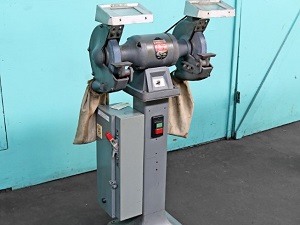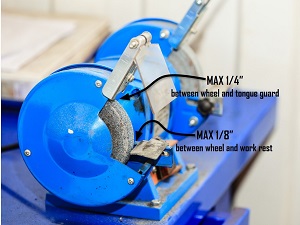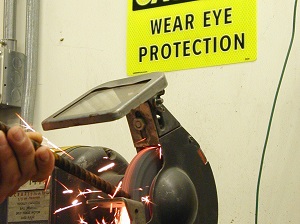Bench and pedestal grinders are standard equipment in a variety of industrial and construction facilities as they are useful for a variety of tasks including grinding, sharpening, rough shaping, cleaning and polishing. This article reviews the safety precautions to consider if bench or pedestal grinders are being used on the job including PPE requirements, preparation of a safe work area, guarding adjustments and equipment inspection.

Bench grinders are mounted to a stable table-top location like a workbench. Pedestal grinders are a stand-alone version that are mounted to a pedestal that may be bolted to the floor or may sit on rubber feet if the machine is heavy enough to remain stable during operation.
There are many hazards to consider when working with bench or pedestal grinders. Because grinders operate at such a high speed, there are many safety hazards that can cause serious or even fatal injuries, including:
- caught-in hazards that can cause crushing injuries and amputations
- wheel explosions that can cause blindness and lacerations
- sparks and heat hazards that can cause abrasions and burns
- flying particles that can cause impact injuries
- dust that can cause respiratory distress

When operating fixed machinery, like a bench or pedestal grinder, many safety precautions should be taken before the work even starts.
Confirm the grinder is permanently and securely mounted to a solid surface like a heavy work bench or the floor. Always refer to manufacturer’s instructions to ensure proper installation of any bench or pedestal grinder.
OSHA Construction Standard 1926.300(b)(6) and General Industry Standard 1910.212(b) Machines designed for a fixed location shall be securely anchored to prevent walking or moving.
Only trained personnel should use bench or pedestal grinders.
Inspect the grinder and all attachments before each use. Safety shields and guards must be in place, adjusted properly and secured before using the grinder.
RPM (revolutions per minute) indicates the maximum operating speed. Make sure the wheel you are using has an RPM rating that meets or exceeds the rating of the tool.
Ensure the wheel that has been selected is appropriate for the task. Do not grind material for which the wheel was not designed. Do not use a wheel that has been dropped, even if it appears undamaged. It could potentially be weakened or unbalanced enough to cause it to disintegrate when used.
OSHA requires that wheels be closely inspected visually and also ring-tested before mounting them on the grinder. This simple test checks for cracks or defects that might otherwise go unnoticed.

On most grinding machines, work rests are used to support the work. The adjustable work rest should be kept adjusted to within 1/8-inch of the wheel. Maintaining a small opening that is 1/8-inch or less prevents the work from being jammed between the wheel and the work rest, which is a hazard that could potentially cause wheel breakage or caught-in injuries for the user.
The upper tongue guard on grinding machines also provides protection for the user, if adjusted properly. The tongue guard should be kept adjusted to within 1/4-inch of the wheel. Maintaining a small opening that is 1/4-inch or less helps deflect sparks during grinding and may also contain parts of the wheel should it shatter during operation.
Adjustments to the work rest or the tongue guard must never be made while the wheel is in motion. Ensure the work rest and the tongue guard are tightly secured after each adjustment. Because the wheel wears down over time, it is important that both the work rest and the tongue guard are regularly checked and adjusted.

Wear PPE that provides the best protection for the task. Always wear approved safety glasses or goggles when using a bench or pedestal grinder. Face protection is highly recommended to protect against flying debris. Evaluate the task and work environment to determine if additional PPE is required like hearing protection, metatarsal foot protection, or respiratory protection.
OSHA Standard 1926.303(c)(9) All employees using abrasive wheels shall be protected by eye protection equipment.
To avoid potential caught-in hazards, gloves should only be worn if using a tool grip that ensures hands are kept several inches from the wheel during the grinding operations. Don’t wear loose clothing or jewelry and make sure long hair is secured.
OSHA Standard 1910.133(a)(1) The employer shall ensure that each affected employee uses appropriate eye or face protection when exposed to eye or face hazards from flying particles.

As a precaution, in case of accidental wheel breakage, stand to one side, not directly in front of the wheel, as the grinder starts up and begins to reach maximum operating speed. Allow the grinder to come up to full operating speed before applying the work to the grinder wheel. Bring work into contact with the grinding wheel slowly and smoothly, applying gradual pressure to allow the wheel to warm up evenly.
Ensure the grinder operates smoothly and is not vibrating. If there are unusual noises or vibrations, turn off the grinder and conduct an inspection to fix the issue before work resumes.
Only use the face of the wheel for grinding operations, not the side. Move the work back and forth across the face of the wheel to prevent grooves from forming on the grinding wheel.
Do not walk away from a grinder that is still in motion. Turn off the grinder when the task is completed and wait until the wheel comes to a complete stop.
Never stick an object into the wheel to attempt to stop the grinder more quickly.

.jpg)

.jpg)